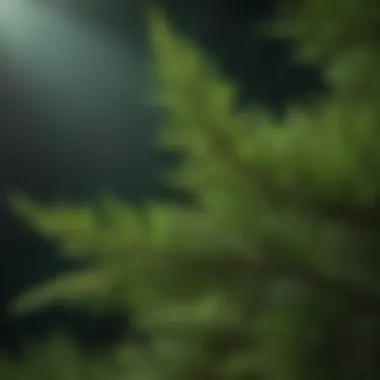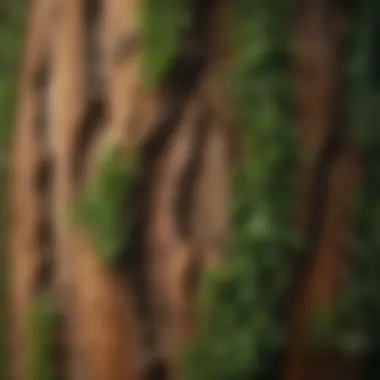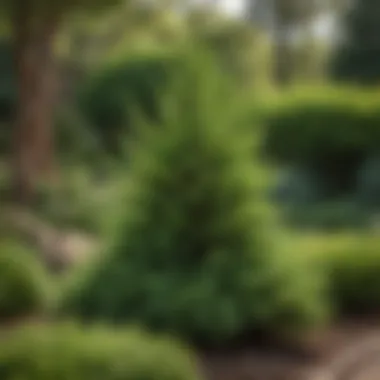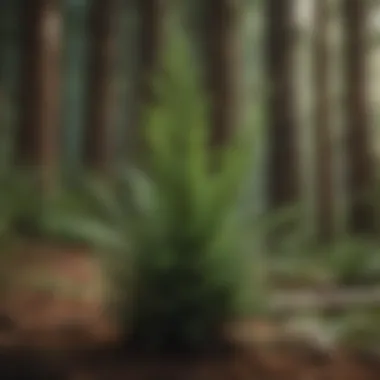Exploring the Green Rocket Hybrid Cedar: Beauty and Resilience


Intro
The Green Rocket Hybrid Cedar stands out as a remarkable coniferous species. Combining aesthetic appeal with functional resilience, it captivates interest from both horticulturists and ecologists alike. Its unique traits and abilities make it a significant player in various fields, from landscaping to ecological conservation. This article aims to delve into its characteristics, uses, and the significance this hybrid holds in contemporary environmental discussions.
Fascinating Facts About the Green Rocket Hybrid Cedar
Unique Characteristics
The Green Rocket Hybrid Cedar is known for its striking appearance and distinctive growth patterns. This species boasts a blend of desirable features, including a slender profile, vibrant foliage, and an impressive growth rate. The hybrid has been crafted through selective breeding, creating an adaptive tree that thrives in multiple environments. One notable trait is its disease resistance, making it a preferred choice for urban and suburban settings.
Extraordinary Abilities
In addition to its resilience, this hybrid cedar showcases unique abilities that contribute to its ecological importance. Its extended root system enables it to access water and nutrients that may be limited in the soil. This characteristic enhances its adaptability to various climatic conditions, which is a significant advantage in nature's changing landscape. Furthermore, its capacity to reduce soil erosion and improve air quality makes it a valuable asset in environmental protection efforts.
Growth Patterns and Ecological Importance
Growth Patterns
Typical growth patterns of the Green Rocket Hybrid Cedar reflect its adaptability to various soils. Generally, it achieves a maximum height of around 15 to 25 feet, depending on local conditions. The tree grows in a pyramidal shape, making it suitable for tight spaces in residential gardens or public parks.
Ecological Importance
The Green Rocket Hybrid Cedar plays a crucial role in local ecosystems. By providing habitat, it supports various wildlife, including birds and insects. The tree also serves as a carbon sink, absorbing CO2 from the atmosphere and contributing to climate change mitigation.
Applications in Landscaping and Construction
The versatility of the Green Rocket Hybrid Cedar is evident in its numerous applications in landscaping and sustainable construction. Its aesthetically pleasing form and foliage attract landscape designers aiming to enhance visual appeal in gardens and parks.
Uses in Landscaping
- Tempering Landscapes: The tree harmonizes with different plants and colors, making it valuable for aesthetic landscaping efforts.
- Privacy Screens: Due to its elevated height and density, it can serve as an effective privacy screen in residential or commercial settings.
Uses in Construction
- Timber Production: The wood from the Green Rocket Hybrid Cedar is prized for its durability and unique grain patterns, making it sought after in the construction industry.
- Erosion Control: Its vigorous root system is utilized for erosion control, particularly in areas susceptible to soil degradation.
The adaptability of the Green Rocket Hybrid Cedar is highlighted by its ability to flourish in diverse climates, supporting its classification as a sustainable choice for landscaping and environmental solutions.
Future Research Directions and Conservation Efforts
Understanding the Green Rocket Hybrid Cedar's potential is vital for future research. As climate change continues to impact natural ecosystems, analyzing how this hybrid responds to varying environmental conditions will be crucial. Moreover, conservation efforts must focus on preserving natural habitats to ensure the survival of this remarkable species.
The exploration of the Green Rocket Hybrid Cedar is essential, revealing its multifaceted contributions to environment and society. From its captivating characteristics to significant ecological roles, it deserves attention from both the scientific community and the public alike.
Prologue to Green Rocket Hybrid Cedar
The Green Rocket Hybrid Cedar represents a significant advancement in horticultural science. It stands out for its aesthetic value and practical applications in various fields. This section will explore its definition, origin, and characteristics. Understanding these elements is vital for appreciating its ecological and utilitarian roles.
Definition and Origin
The Green Rocket Hybrid Cedar is a specific type of conifer that has been bred for its desirable traits. Originating from traditional cedar species, it has been crossbred to enhance particular attributes like growth rate, disease resistance, and aesthetic appeal. This hybridization was carefully carried out to combine the best qualities of its parent species. The result is a tree known for its resilience and striking appearance. Its origin can be traced back to innovative horticultural practices aimed at creating a more versatile tree. The need for such a hybrid arose from the demand for trees that are not only beautiful but also capable of thriving in diverse environmental conditions.
Characteristics of the Hybrid
Several key characteristics define the Green Rocket Hybrid Cedar. It typically features a conical shape, making it suitable for various landscaping applications. The foliage is dense and has a rich green color that can remain vibrant throughout the year. This characteristic alone makes it a preferred option in many gardens and parks.


Another important trait is its growth rate. The Green Rocket tends to grow faster than many other cedar species, reaching substantial heights within a relatively short period. Height projections can range between 15 to 25 feet, depending on its growing conditions. Its width can vary as well, adding to its appeal for landscapers looking for a versatile tree.
Moreover, this hybrid exhibits a notable degree of pest and disease resistance. This quality greatly reduces the need for chemical treatments, making it an eco-friendly choice. The adaptability to various soil types means it can thrive in both sandy and clay soils, which further highlights its value in diverse landscaping and environmental conservation projects.
One of the remarkable aspects of the Green Rocket Hybrid Cedar is its ability to maintain health and vitality across different climates, making it a sustainable choice for future gardens and green spaces.
In summary, the Green Rocket Hybrid Cedar is not just another ornamental tree; it is a blend of beauty and functionality. Understanding its characteristics provides a deeper appreciation for its role in both aesthetic and ecological contexts.
Botanical Classification
Understanding the botanical classification of the Green Rocket Hybrid Cedar provides vital insights into its biology, ecology, and potential applications. This classification not only helps to identify the tree within the vast tapestry of plant life but also elucidates its relationships with other species, informing both horticulturists and conservationists about the hybrid's unique features and requirements. An accurate taxonomy can enhance cultivation practices, improve conservation strategies, and significantly contribute to the sustainable use of this remarkable conifer.
Taxonomy and Nomenclature
The Green Rocket Hybrid Cedar is a product of sophisticated hybridization, combining characteristics of both Eastern Red Cedar (Juniperus virginiana) and Western Red Cedar (Thuja plicata). This blending results in a tree that embodies the best traits of both species. The nomenclature can often reflect these origins. It highlights its hybrid nature and aids in understanding its growth patterns and adaptations.
Familiarity with the nomenclature aids horticulturists in locating resources specific to this hybrid, ensuring its successful propagation and care. Essentially, the correct taxonomic classification is integral for communicating clear information across various scientific and commercial sectors.
Related Species
The Green Rocket Hybrid Cedar is situated within a broader family of conifers that encompasses a diverse range of trees. Some notable related species include:
- Eastern Red Cedar (Juniperus virginiana): A hardy tree known for its aromatic wood, suitable for various uses.
- Western Red Cedar (Thuja plicata): Valued for its resistance to decay and versatility as a building material.
- Northern White Cedar (Thuja occidentalis): Commonly found in wetlands, this tree also offers durability in construction.
These related species share similar growth environments and growth habits. Thus, studying them can enhance understanding of the Green Rocket Hybrid Cedar's growth requirements and ecological interactions. It's also vital for potential breeding programs aimed at improving resilience and adaptability.
The significance of botanical classification lies not only in the accurate identification of species but also in understanding their ecological roles and conservation needs. Every tree in its family contributes to a more significant ecological balance, and the Green Rocket Hybrid Cedar is no exception.
Growth Patterns
Understanding the growth patterns of the Green Rocket Hybrid Cedar is crucial for various stakeholders, including horticulturists, environmentalists, and families interested in planting. The growth patterns reveal the optimal conditions necessary for successful cultivation. Moreover, knowledge of these aspects can aid in conservation efforts and landscaping decisions.
Ideal Growing Conditions
The Green Rocket Hybrid Cedar thrives best in specific growing conditions. It prefers well-drained soil with a rich organic content. These trees demonstrate a distinct preference for partial to full sunlight, which plays a key role in their growth. The ideal pH range for the soil is between 6.0 and 7.5, offering a slightly acidic to neutral environment. Adequate moisture is also critical; however, the tree must not be subjected to standing water, as this can lead to root rot. Additionally, this hybrid cedar adapts well to various climates but excels in regions with moderate rainfall and temperate conditions. Maintaining these ideal conditions encourages robust growth and enhances the tree's resilience.
Height and Width Projections
When growing, the Green Rocket Hybrid Cedar exhibits impressive height and width. Typically, the tree can reach up to 30 feet in height when fully mature. Its growth rate is moderate, allowing for steady development over the years. In terms of width, it can spread to about 10 to 15 feet. Understanding these projections is vital for anyone considering planting this tree, as space should be adequately allocated. This information aids in planning landscapes or garden designs, ensuring that the hybrid cedar does not overcrowd surrounding plants. Proper spacing also promotes good air circulation, which is beneficial for overall health.
Lifespan and Longevity
The lifespan of the Green Rocket Hybrid Cedar is another noteworthy aspect. On average, these trees can live for 50 to 70 years, presenting a long-term investment for landscaping and conservation. Their longevity makes them suitable for various settings, from private gardens to public parks. Proper care, such as adequate watering and periodic pruning, can extend their lifespan even further. Understanding the life expectancy of this hybrid cedar can guide planting decisions, especially in scenarios where long-term ecological impacts are desired.
In summary, recognizing the growth patterns of the Green Rocket Hybrid Cedar can facilitate informed decisions for both aesthetic appeal and ecological contribution.
Ecological Importance
The ecological importance of the Green Rocket Hybrid Cedar cannot be overstated. As a unique coniferous species, it plays a significant role in maintaining healthy ecosystems. Its structural and functional traits make it beneficial in various environmental contexts. Understanding these aspects is essential for determining its value in both natural habitats and human-managed landscapes.
Role in Biodiversity
The Green Rocket Hybrid Cedar contributes to biodiversity in various ways. First, it provides habitat and food for a range of species, including birds, insects, and small mammals. The tree's foliage offers shelter, while its seeds serve as a food source in the ecosystem. Additionally, its presence supports a more diverse plant community, fostering interactions among different life forms.
Another critical role of this hybrid Cedar is its ability to attract pollinators. Many flowering plants rely on insects for reproduction, and the Green Rocket Hybrid Cedar can enhance local biodiversity by supporting these crucial species. This interdependence illustrates how each component of an ecosystem, including the hybrid Cedar, fosters a network of life.
Habitat and Ecosystem Contributions


The habitat provided by the Green Rocket Hybrid Cedar is essential for maintaining ecosystem balance. It stabilizes soil, reducing erosion and promoting water retention, which is vital for sustaining other plant species. The tree also plays a role in carbon sequestration, thus contributing to climate regulation. This aspect is increasingly important in the face of global climate change, highlighting the hybrid's ecological significance.
Furthermore, the Green Rocket Hybrid Cedar's adaptability to different conditions allows it to thrive in varied environments. This trait enhances its habitat contribution, enabling it to serve in numerous ecological niches. Overall, the hybrid Cedar emerges as a key player in sustaining ecosystem health and supporting biodiversity.
The Green Rocket Hybrid Cedar is not just a tree; it’s a cornerstone species that enriches biodiversity and promotes ecological balance.
In sum, the ecological importance of the Green Rocket Hybrid Cedar emphasizes its role as a biodiversity enhancer and habitat provider, making it a valuable asset to both natural environments and human landscapes.
Applications of Green Rocket Hybrid Cedar
The Green Rocket Hybrid Cedar has several applications that extend beyond mere aesthetic appeal. Its characteristics make it suitable in diverse fields such as landscaping, construction, and environmental conservation. Utilizing this hybrid species can lead to benefits that are not only practical but also contribute to ecological stability.
Landscaping Uses
In landscaping, the Green Rocket Hybrid Cedar serves as an attractive and versatile choice. Its tall, narrow form allows it to create defined borders and privacy screens without taking up excess horizontal space. This is particularly valuable in urban settings where space is limited. The rich green color and texture of these trees can enhance a landscape, providing a striking contrast against other plants.
Beyond aesthetics, the Green Rocket can help mitigate noise pollution. Its dense foliage acts as a sound barrier, making it ideal for residential areas near busy streets. Moreover, due to its adaptability to various soil types, it can thrive in both sandy and clay-heavy environments, making it a pragmatic selection for diverse geographical locations.
Construction Material
The wood of the Green Rocket Hybrid Cedar is known for its durability and resistance to decay. This makes it an excellent candidate for various construction purposes. Its natural properties help in reducing the need for chemical treatments often required for other types of wood. Builders and architects can use this material in outdoor structures, such as decks, fences, and garden furniture.
Using Green Rocket wood can lead not only to sustainable building practices but also contribute to a lower carbon footprint. The cultivation of these trees can provide renewable resources that diminish reliance on non-sustainable timber sources. Architects looking to incorporate eco-friendly materials into their designs will find this hybrid cedar highly relevant.
Environmental Conservation Efforts
The Green Rocket Hybrid Cedar plays a significant role in environmental conservation. Planting these trees can improve local ecosystems by providing habitats for various wildlife species. Their ability to absorb carbon dioxide and produce oxygen contributes positively to air quality, and their roots help prevent soil erosion.
In addition to enhancing biodiversity, this hybrid supports conservation strategies aimed at restoring degraded areas. As a resilient species, the Green Rocket can adapt to changing environmental conditions, making it a strong candidate for reforestation projects.
This tree not only beautifies our surroundings but also signifies our commitment to ecological sustainability.
Through education and local community engagement, the promotion of the Green Rocket Hybrid Cedar can foster a culture of conservation. Understanding its potential helps stakeholders advocate for its integration into urban planning and green space development.
Adaptability and Resilience
The Green Rocket Hybrid Cedar displays remarkable adaptability and resilience. These qualities are essential for its survival and optimal growth in varying environmental conditions. Understanding this topic is crucial for anyone interested in horticulture, landscaping, and conservation. With the right conditions, this hybrid can thrive in various climates, offering both aesthetic and functional benefits.
Climate Adaptability
The Green Rocket Hybrid Cedar can adapt to a range of climatic conditions. This adaptability makes it suitable for many regions. It can endure extreme temperatures, from hot summers to cold winters. The tree can also thrive in areas with varying rainfall, which is a significant advantage for areas affected by climate variability.
Factors that contribute to its climate adaptability include:
- Drought Resistance: The tree’s ability to conserve water is vital during dry spells.
- Frost Tolerance: It withstands frosts better than many other conifers, allowing it to be planted in cooler zones.
- Heat Tolerance: The hybrid's resilience to heat makes it a good choice for warmer climates.
This characteristic makes the Green Rocket Hybrid Cedar a valuable asset in an era where climate change impacts numerous species.
Soil Compatibility
Soil compatibility is another significant trait of the Green Rocket Hybrid Cedar. This hybrid can grow in various soil types, from sandy soils to clay. The tree prefers well-drained soils but can adapt to different pH levels, which expands its potential planting sites. This flexibility allows it to establish in both urban and rural environments.
Key points about soil compatibility:
- Nutrient Requirements: It is not overly demanding regarding nutrient levels, making it easier for beginner gardeners.
- Erosion Control: Its root system helps stabilize soil, preventing erosion in areas susceptible to runoff.
- Growth in Less Ideal Conditions: The hybrid doesn't require perfect soil quality, making it an excellent choice for restoration projects.


Understanding its soil compatibility aids in planning successful planting and landscaping projects.
Pest and Disease Resistance
The Green Rocket Hybrid Cedar displays notable pest and disease resistance. This quality is essential for longevity and reducing maintenance needs in both commercial and residential settings. Specialty breeders have developed this tree to resist common diseases and pests that typically afflict conifers.
Some benefits of its resistance include:
- Lower Maintenance: Fewer pests mean less need for chemical treatments.
- Longer Lifespan: Healthy trees can live longer and maintain their beauty over time.
- Eco-Friendly Option: Resistance to diseases and pests contributes to reducing the ecological impact of gardening and landscaping.
Incorporating this hybrid into landscaping can lead to healthier ecosystems and less chemical usage.
The Green Rocket Hybrid Cedar exemplifies adaptability and resilience, making it ideal for modern gardening and conservation initiatives.
Future Research Directions
Research into the Green Rocket Hybrid Cedar presents significant opportunities for understanding its unique characteristics and enhancing its ecological and practical applications. This section discusses potential genetic studies and conservation strategies, highlighting their importance in ensuring the longevity and sustainability of this hybrid tree species.
Potential Genetic Studies
Genetic studies on the Green Rocket Hybrid Cedar can provide valuable insights into its adaptability and resilience. Such research may focus on understanding the genetic makeup that contributes to its pest resistance and environmental hardiness. Scientists can explore the genes associated with specific traits, like growth rate and drought tolerance.
Key areas of interest include:
- Identifying resistant genes: This involves analyzing genetic material to find traits that contribute to resistance against pests and diseases.
- Hybrid vigor analysis: By understanding how hybridization affects growth and environmental tolerance, researchers can optimize breeding programs.
- Climate adaptability research: Genetic studies can reveal how these trees respond to different climatic conditions, thus informing future planting strategies.
Investigating these genetic aspects can lead to improved cultivation practices, enhancing the tree's value as a sustainable resource in horticulture.
Conservation Strategies
The prioritization of conservation strategies for the Green Rocket Hybrid Cedar is essential, given its ecological significance. Protecting this species involves both in-situ (natural habitat) and ex-situ (external) approaches. Effective conservation requires collaboration among conservationists, local communities, and governments.
Consider the following strategies:
- Habitat preservation: Protecting natural habitats from urbanization and industrial impact is crucial for maintaining the ecosystems where these trees thrive.
- Public awareness campaigns: Educating communities about the environmental importance of the Green Rocket Hybrid Cedar can improve conservation efforts and promote responsible land use.
- Seed banks and nurseries: Establishing seed banks ensures that genetic diversity is preserved. Nurseries can grow seedlings for reforestation or landscaping projects, promoting the use of this hybrid species widely.
Investing in research today ensures a greener tomorrow.
By prioritizing genetic advancements and developing comprehensive conservation strategies, we can secure the survival and utility of this remarkable tree for generations to come.
End
The discussion surrounding the Green Rocket Hybrid Cedar emphasizes its multifaceted importance in today's horticulture and conservation practices. This hybrid species not only exhibits aesthetic appeal but also serves significant ecological roles. Several specific elements underscore its relevance.
Firstly, the adaptability of the Green Rocket Hybrid Cedar to various climates makes it a valuable resource for landscaping and environmental restoration projects. Its resilience in diverse soil conditions enhances its suitability for urban and rural applications alike, enabling it to flourish in a range of settings.
Secondly, its growth patterns and longevity mean that investment in this hybrid is not merely immediate. With the proper care, these trees can provide shade, beauty, and habitat for countless species over decades. This long lifespan contributes to its reputation as a sustainable choice for gardening and provides real benefits to local biodiversity systems.
In terms of conservation, the Green Rocket Hybrid Cedar presents opportunities for researchers and practitioners to explore further. By developing conservation strategies, we can ensure that this remarkable species thrives for future generations. Researchers can examine genetic variations and resilience factors to improve planting success rates and support ecological balance.
Overall, the Green Rocket Hybrid Cedar signifies a merging of aesthetic landscaping goals with pragmatic environmental concerns. Incorporating such species into horticultural practices may lead to a healthier ecosystem, addressing climate change, and promoting biodiversity. As the discourse on sustainable practices grows, the Green Rocket Hybrid Cedar stands as a noteworthy example of what modern horticulture can achieve.
“In integrating aesthetic values with ecological necessities, the Green Rocket Hybrid Cedar becomes more than just a plant; it represents a broader vision for sustainable living.”
Significance in Modern Horticulture and Conservation
The significance of the Green Rocket Hybrid Cedar in modern horticulture cannot be overstated. This tree species embodies the principles of aesthetic design and ecological integrity. Gardens and landscapes featuring this hybrid can enhance not only beauty but also support local wildlife.
Additionally, as urbanization continues to stretch natural habitats, the use of such resilient species becomes crucial. The hybrid's capacity to thrive in urban conditions offers a solution to combat the loss of greenery in cities. Integrating it into urban environments can significantly improve air quality and reduce heat islands.
As conservation efforts intensify globally, the Green Rocket Hybrid Cedar serves a dual purpose. On one hand, it provides a robust framework for landscaping, while on the other, it reinforces the habitats necessary for various wildlife species.
Finally, educating communities about the ecological contributions of the Green Rocket Hybrid Cedar fosters stewardship. Understanding its role in carbon sequestration and biodiversity can galvanize conservation efforts at the local level. In this way, adopting this hybrid is an investment in both aesthetic appeal and environmental responsibility.







